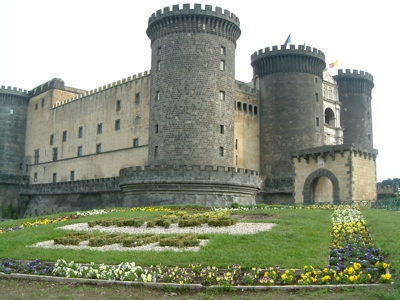
|
|
Hi, let us introduce ourselves: we are a group of twenty mothers living in the centre of Naples and we are attending a course of English language organized by our children's school.
We wish to be helpful to the several tourists crowding Naples in these years by giving them some suggestions about what to visit in this beautiful town.
There are lots of guides focused on adults' interests , but what about children? All of us know how it's hard travelling with children: visiting new places it's interesting and discovering them together with our chilren makes it even more pleasant.
But children soon get sick of museums and churches and a nice experience can turn into a nightmare if you aren't able to propose them amusing or diverting activities.
Our main aim is giving a hand to those tourists facing a journey with their little children by pointing out some attractions that can be interesting both for adults and children.
So, if you are interested in this topic, visit this blog in the next weeks: we are going to fill it with more and more information.
Area personale
Tag
Cerca in questo Blog
Menu
I miei Blog Amici
Ultimi commenti
Chi può scrivere sul blog
| « UNDERGROUND NAPLES | THE REGGIA OF CAPODIMONTE » |
NEAPOLITAN CASTLES
Children are always fascinated by stories of kings and knights. So they will be certainly interested in a tour of Neapolitan castles.
Naples has got 4 castles and 3 Royal Palaces, located in different areas of the city and with different origins. The most famous is Castel dell’Ovo, with its characteristic shape standing out on the Neapolitan seashore. The building is located on a small island, the Megaride, that is the first inhabited nucleus in Naples, founded in the 6th century B.C. Here the Roman patrician Lucullus built his villa in the 1st century B.C. Here was exiled the last western Roman Emperor, Romolus Augustulus, in the 5th century A.D. On the remains of the Villa, Normans built a castle in 12th century. But it lost its importance when in 13th century the new king Anjou built a more comfortable and safer castle, the Maschio Angioino, also called Castelnuovo (new castle)and moved his court there.
The castle’s name spreads out from a medieval legend telling that the latin poet Virgil, who in middle age was believed to be a sorcerer, put a magical egg into the foundations of the castle to support them, and foresaw that if the egg broke, it would have been the end for the castle and doomsday for Naples. This castle offers a magnificent view of the gulf of Naples from its terraces and inside it often go exhibitions and other special events. In the 1800 a small fishing village (Borgo Marinari) sprung up around the castle, this village is still existing but is now renowned for its picturesque marina and several fine restaurants.
The other castle, that is the first monument you see coming from the sea, is Castel Nuovo that, was built for strategic reasons, in order to warden the port by the new French dominators. It is in Gothic style, with  5 towers, and its Chapel was decorated by frescoes by Giotto, but unfortunately, almost nothing is left of them. It was radically restored by the following dominating dynasty, the Aragona.
5 towers, and its Chapel was decorated by frescoes by Giotto, but unfortunately, almost nothing is left of them. It was radically restored by the following dominating dynasty, the Aragona.
A famous triumphal arch was added to the main gate to celebrate Alfonso d’Aragona’s entrance in Naples.
In a hall of the castle the famous Barons conspiracy against King Ferrante, Alfonso's son, occurred. The King had invited the barons for a feast; but, a certain point, he had the garrison close all the hall's doors and all the barons were arrested and later executed. The Barons' Hall was the seat of the Council of the commune of Naples until 2006.
by Gaia
|
|




Inviato da: peluches le blog
il 16/08/2013 alle 10:27
Inviato da: vivienne westwood
il 13/10/2011 alle 10:03
Inviato da: tattoosupplies888
il 08/09/2010 alle 10:11
Inviato da: Anonimo
il 23/03/2008 alle 16:43
Inviato da: Anonimo
il 25/12/2007 alle 22:43